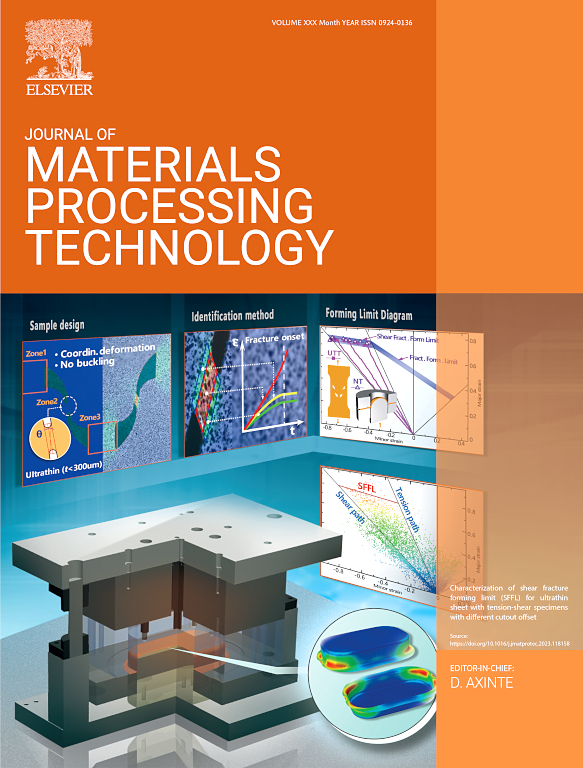Magnetically controlled homogenised plasma-assisted mechanochemical lapping of calcium fluoride optical components
IF 7.5
2区 材料科学
Q1 ENGINEERING, INDUSTRIAL
Journal of Materials Processing Technology
Pub Date : 2025-07-23
DOI:10.1016/j.jmatprotec.2025.118993
引用次数: 0
Abstract
Calcium fluoride (CaF₂) optical components are ideal candidates for potential applications in Inertial Confinement Fusion megascience facilities. However, their high brittleness and chemical inertness pose significant challenges in achieving uniformity and near-damage-free processing for large-aperture optical elements. To address this, this study innovatively employs magnetron-controlled H₂O(g) plasma to homogeneously modify CaF2 surfaces, effectively reducing material brittleness and expanding the ductile-domain machinable scale. A strategy integrating strongly oxidative mechanochemical lapping tools is proposed, enabling contact-based chemical modification followed by soft abrasive removal, thereby realizing high-precision flattening of large-aperture optical components. Through multiscale simulations and experimental validation, the mechanisms of magnetron plasma homogenization and mechanochemical lapping-induced surface generation are systematically elucidated. Results demonstrate that the magnetron plasma-modified layer exhibits excellent uniformity with a modification depth of approximately 50 nm. After oxidative composite abrasive mechanochemical lapping, the plasma-modified layer is preferentially removed at an enhanced efficiency of 172 nm/min without introducing secondary damage. The processed CaF₂ surface achieves a surface roughness of 1.1 nm. This research propels the application of magnetically controlled homogenized plasma modification technology in ultra-precision machining, establishing critical technical support for processing advanced optical components.
磁控均匀等离子体辅助氟化钙光学元件的机械化学研磨
氟化钙(CaF₂)光学元件是惯性约束聚变大型科学设施潜在应用的理想候选者。然而,它们的高脆性和化学惰性对实现大孔径光学元件的均匀性和近无损伤加工提出了重大挑战。为了解决这一问题,本研究创新性地采用磁控管控制的h2o (g)等离子体对CaF2表面进行均匀修饰,有效降低了材料脆性,扩大了韧性域可加工规模。提出了一种集成强氧化性机械化学研磨工具的策略,实现基于接触的化学改性,然后进行软磨料去除,从而实现大口径光学元件的高精度平坦化。通过多尺度模拟和实验验证,系统阐述了磁控管等离子体均匀化和机械化学研磨诱导表面生成的机理。结果表明,磁控管等离子体修饰层具有良好的均匀性,修饰深度约为50 nm。氧化复合磨料机械化学研磨后,等离子体修饰层以172 nm/min的效率优先去除,而不会产生二次损伤。加工后的CaF₂表面粗糙度达到1.1 nm。本研究推动了磁控均质等离子体改性技术在超精密加工中的应用,为加工先进光学元件奠定了关键技术支撑。
本文章由计算机程序翻译,如有差异,请以英文原文为准。
求助全文
约1分钟内获得全文
求助全文
来源期刊

Journal of Materials Processing Technology
工程技术-材料科学:综合
CiteScore
12.60
自引率
4.80%
发文量
403
审稿时长
29 days
期刊介绍:
The Journal of Materials Processing Technology covers the processing techniques used in manufacturing components from metals and other materials. The journal aims to publish full research papers of original, significant and rigorous work and so to contribute to increased production efficiency and improved component performance.
Areas of interest to the journal include:
• Casting, forming and machining
• Additive processing and joining technologies
• The evolution of material properties under the specific conditions met in manufacturing processes
• Surface engineering when it relates specifically to a manufacturing process
• Design and behavior of equipment and tools.
 求助内容:
求助内容: 应助结果提醒方式:
应助结果提醒方式:


